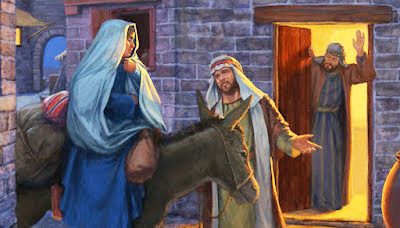Since childhood it was explained to us at Christmas Mass: “In those days a decree went out from Caesar Augustus that all the world should be registered…while Quirinius was governor of Syria…all went to their own towns to be registered.” (Luke 2.1-3). That’s why Mary gave birth in Bethlehem.
As we grew older, this business of requiring an entire population to drop everything to go to their hometowns to be counted didn’t make sense. Did everyone have a birth certificate? How many local storekeepers and shepherds had to abandon their stores and flocks in Nazareth to leave town? Mary wasn’t from Bethlehem, so where was she counted? As you can guess, most Biblical scholars question Luke’s version of history.

Luke never knew Jesus. Like the other authors of the New Testament, he was writing decades after the Christ. However, it was of vital importance to link Jesus with the old Israelite King David in order to convince Jews that Jesus was of royal blood and foretold by the old prophets. Bethlehem was the birthplace of King David, and if Joseph was of the House of David, then Jesus needed roots in Bethlehem.
Jesus grew up in Nazareth which is in the district of Galilee. Bethlehem is in the district of Judea, 90 miles from Nazareth—a four-day journey. Despite the retroactive “documentation,” Jesus was always known as the “Nazarene.” To make his birth in Bethlehem believable Luke connected it to a Roman census.
The Romans were bean-counters. They had to be in order to maintain a Republic. Just as we count Americans every ten years to determine House representation, the Romans used to count every five years for their assemblies. Among the great accomplishments of Caesar Augustus was a number of censuses of Italy, one of which in 8 B.C. counted 4,233,000 Italians (not slaves). But there is no record of ordering Italians back to their hometowns. There is no logic to that, we don’t do that now, why would Judeans have to do that?
Luke writes that the census occurred during the governorship of Publius Sulpicius Quirinius. (Note: Sulpizio is still a fairly common Italian surname). History does record a census by Quirinius but in A.D. 6, six years after the birth of Jesus. (Perhaps Jesus was actually born then, if so, all our dating is messed up.) Leaving that aside, to make the first Christmas happen we need a logical census and a journey to Bethlehem. This is when my ‘Jesus moment’ arrived.
By A.D. 6, King Herod the Great, builder of the Second Temple in Jerusalem, was dead. Herod had ruled all districts of Palestine (Galilee, Judea, and Samaria). At his death Palestine was divided among his three sons. But Emperor Augustus had no use for one of the sons, so his district, Judea, was assigned to the Roman governor of Syria— our old friend Quirinius. Judea was subsequently ruled directly by Rome which meant that the Roman bean-counters had to establish a new property tax base.
For those of you saddled with real estate taxes, you know the drill. Your house and property are given an assessment reflecting market value and you pay (or appeal) to the local government whatever tax rate is imposed.
It was possible that Joseph, who was a lot older than Mary, owned property in his hometown of Bethlehem. Although he lived in Nazareth with Mary, he must now go to Bethlehem to negotiate his assessment with the Roman tax man. This is not a population census as we are led to believe, but a property census. Such a census doesn’t require thousands of people to make unnecessary treks to their birthplace, only the few out-of-town property owners. If Joseph doesn’t go, his taxes may be overstated. He has to take pregnant Mary with him.
As an absentee landlord, Joseph could have been renting his Bethlehem property. He couldn’t put his tenant out, so he and Mary needed other accommodations. They end up, perhaps, in an unoccupied ‘stable’ on or near his property.
Does this scenario lessen the wonder of Christmas? Does the reason for the trip to Bethlehem really matter? -JLM




Recent Comments